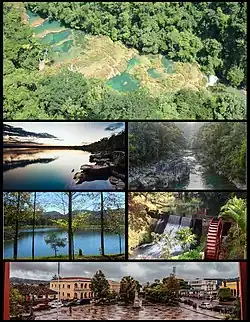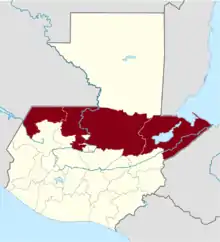Alta Verapaz Department
Departamento de Alta Verapaz | |
|---|---|
 Clockwise from top: Semuc Champey in Lanquin, Lachua Lagoon in Coban, Cahabon river in San Pedro Carcha, Chichoj Lagoon in San Cristobal Verapaz, Finca Aurora in San Cristobal Verapaz & Coban Central Park | |
 Flag  Coat of arms | |
 Alta Verapaz | |
| Coordinates: 15°30′N 90°20′W / 15.500°N 90.333°W | |
| Country | |
| Capital | Cobán |
| Municipalities | 16 |
| Government | |
| • Type | Departmental |
| • Governor | Fernando Jeremías Rodríguez Klarck |
| Area | |
| • Department of Guatemala | 8,686 km2 (3,354 sq mi) |
| Highest elevation | 2,800 m (9,200 ft) |
| Lowest elevation | 300 m (1,000 ft) |
| Population (2018)[1] | |
| • Department of Guatemala | 1,215,038 |
| • Density | 140/km2 (360/sq mi) |
| • Urban | 379,708 |
| • Ethnicities | Q'eqchi' Poqomchiʼ Ladino |
| • Religions | Roman Catholicism Evangelicalism Maya |
| Time zone | UTC-6 |
| ISO 3166 code | GT-AV |
15°30′N 90°20′W / 15.500°N 90.333°W
Alta Verapaz (Spanish pronunciation: [ˈalta βeɾaˈpas]) is a department in the north central part of Guatemala. The capital and chief city of the department is Cobán. Verapaz is bordered to the north by El Petén, to the east by Izabal, to the south by Zacapa, El Progreso, and Baja Verapaz, and to the west by El Quiché.
Also in Alta Verapaz are the towns of Chisec, San Pedro Carchá and San Cristóbal Verapaz.
History

In pre-Columbian times, this area was part of the Maya civilization. When the Spanish Conquistadores came in the 1520s they conquered the central and southern highlands of Guatemala, but were driven back from this region by fierce native resistance. Unknown to the history books of this region, local oral history speaks of a former slave ship capsizing prior to the Spaniards arriving upon this area. The former African slaves moved inland, and joined forces with the local indigenous people to fight and maintain their freedom. Spanish friars succeeded in converting the area to Christianity, and named the area "Verapaz" meaning "True Peace". In the 19th century this became an important coffee producing region as well as a sugar cane plantation during prior centuries. A museum exists today highlighting the sugar plantation history. In this region of Guatemala, families that trace back their heritage before the Spanish conquest, can trace back their Mayan features and curly hair to that local oral history. Majority of pre-Columbian heritage is seen with straight black hair throughout Guatemala.
The department was called Vera Paz by the British in the 19th century. In 1850, the department had an estimated population of 66,000.[2]
As a result of the Mexican Drug War, the Los Zetas drug cartel members overtook much of the department and occupied many towns in December 2010. The Guatemalan government declared a state of siege on December 19, 2010, to reclaim the department, allowing the military and police forces to search and arrest any suspects without a warrant, and at least sixteen buildings were searched.[3][4]
Municipalities
References
- ↑ Citypopulation.de Population of departments in Guatemala
- ↑ Baily, John (1850). Central America; Describing Each of the States of Guatemala, Honduras, Salvador, Nicaragua, and Costa Rica. London: Trelawney Saunders. pp. 86–87.
- ↑ Wire Staff, the CNN (December 20, 2010). "Guatemalan government declares siege to fend off drug gang". Cable News Network. Archived from the original on November 9, 2012. Retrieved 20 December 2010.
{{cite news}}:|first=has generic name (help) - ↑ AP, Google (December 19, 2010). "Guatemalan military seizes drug-plagued province". The Associated Press. Retrieved 20 December 2010.
{{cite news}}:|first=has generic name (help)
External links
![]() Media related to Alta Verapaz Department at Wikimedia Commons
Media related to Alta Verapaz Department at Wikimedia Commons
